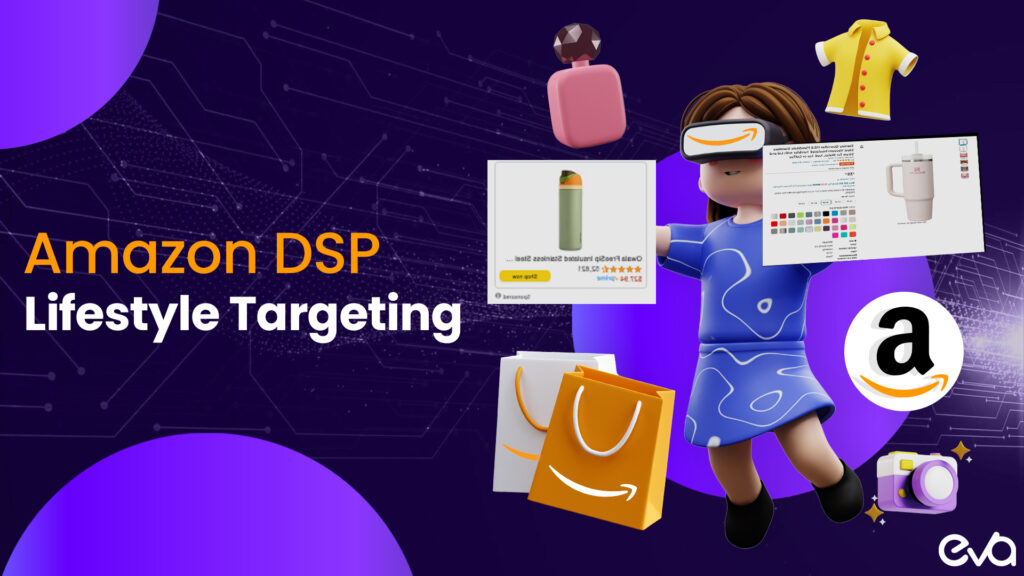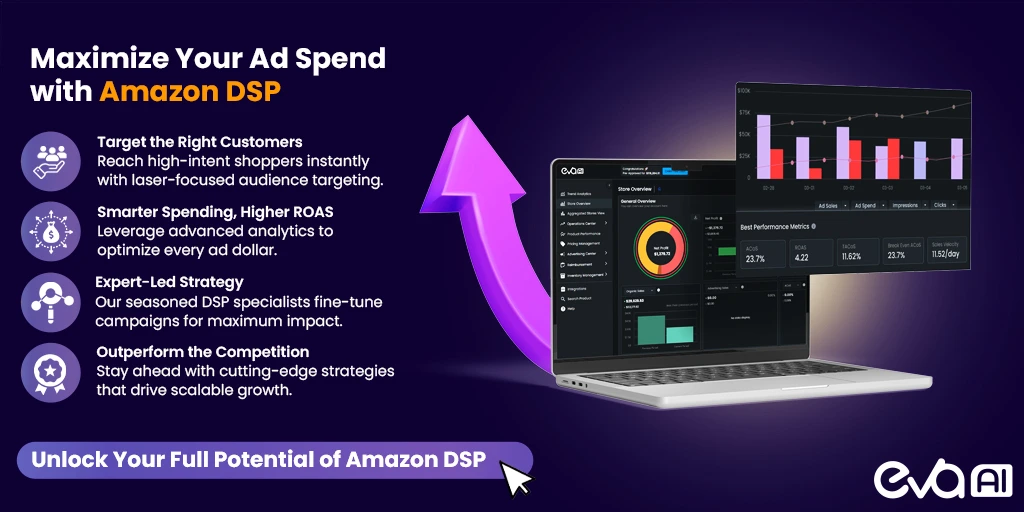Table of Contents
- Introduction
- What is Lifestyle Targeting?
- Amazon DSP Lifestyle Targeting vs Traditional Advertising Platforms
- Key Advantages of Using Amazon DSP for Targeting Specific Audiences
- Why Focus on Lifestyle Targeting?
- Retargeting and Remarketing
- Benefits of Lifestyle Targeting
- How Amazon DSP Implements Lifestyle Targeting
- Strategies for Effective Lifestyle Targeting with Amazon DSP
- Optimizing Lifestyle Targeting
- Ad Examples and Creative Strategies
- Creative Strategies to Engage Lifestyle-Targeted Audiences
- How Eva Can Enhance Your Amazon DSP Campaigns
- Conclusion
Introduction
Amazon DSP is pivotal in digital advertising because it combines the power of programmatic advertising with Amazon’s vast consumer data.
This combination allows advertisers to target highly specific audiences based on demographics, behavior, interests, and purchase history.
Unlike traditional advertising platforms, Amazon DSP provides insights directly tied to consumer purchasing behaviors, making it a crucial tool for brands looking to optimize their advertising spend and achieve better returns on investment (ROI).
What is Lifestyle Targeting?
Lifestyle targeting is an advanced advertising strategy that focuses on reaching audiences based on their interests, behaviors, and values.
This method goes beyond demographic targeting to consider the lifestyle choices that influence consumer purchasing decisions.
Definition of Lifestyle Targeting
Lifestyle targeting involves segmenting audiences based on factors such as hobbies, interests, and cultural values.
By understanding these aspects of consumer behavior, advertisers can deliver highly relevant ads that resonate with the audience on a personal level.
Explanation of Lifestyle Targeting in Digital Advertising
In digital advertising, lifestyle targeting allows brands to connect with consumers by aligning their ads with the values and interests that matter most to their target audience.
This approach is particularly effective in building brand loyalty and driving long-term engagement.
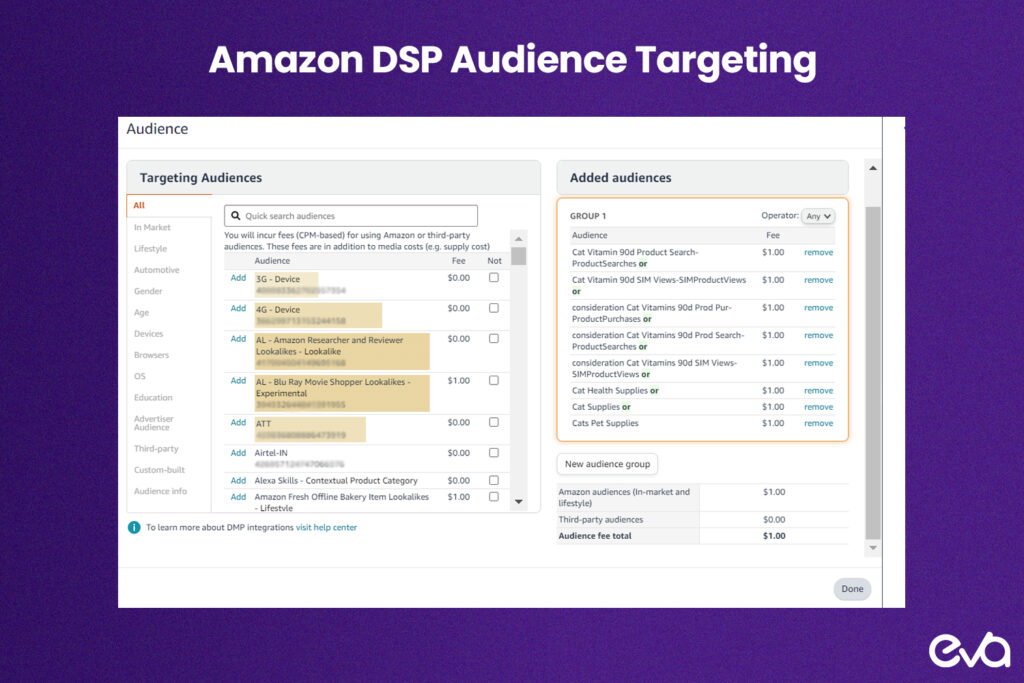
Amazon DSP Lifestyle Targeting vs Traditional Advertising Platforms
Compared to traditional advertising platforms, Amazon DSP offers several key advantages:
- First-Party Data Access: Amazon DSP leverages Amazon’s own data, which includes detailed insights into consumer shopping behaviors, preferences, and purchasing patterns.
- Advanced Targeting Capabilities: With features like lifestyle targeting and contextual targeting, Amazon DSP enables advertisers to create highly personalized ad experiences.
- Cross-Platform Reach: Amazon DSP allows advertisers to reach audiences not only on Amazon.com but also across a wide range of external websites, mobile apps, and streaming services.
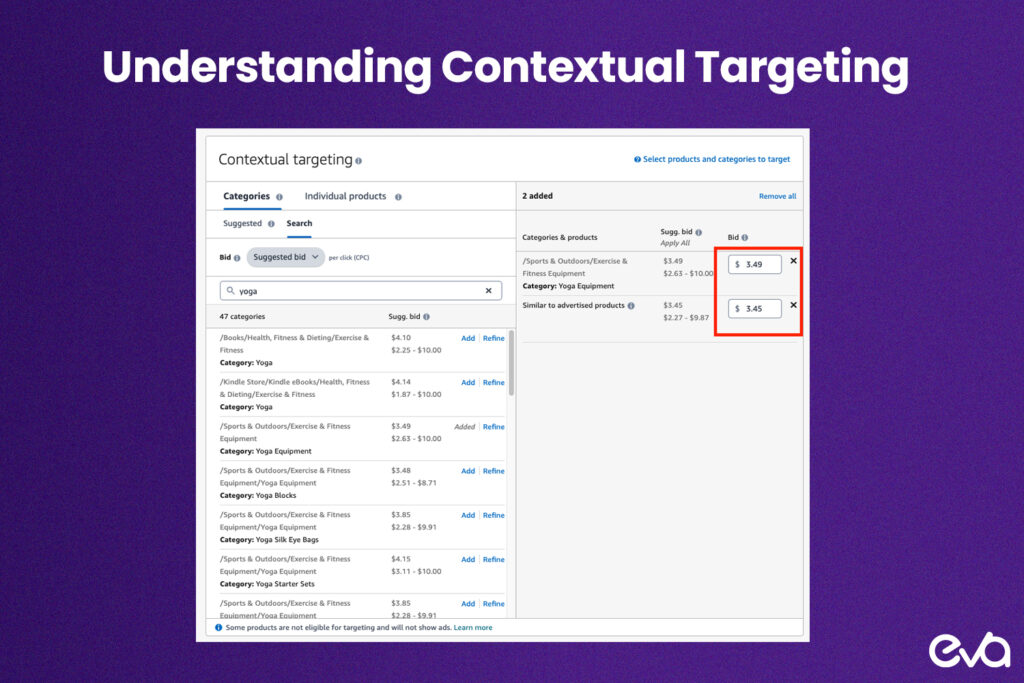
Key Advantages of Using Amazon DSP for Targeting Specific Audiences
- Precision Targeting: Amazon DSP’s ability to target based on lifestyle, interests, and purchase history allows for highly accurate audience segmentation.
- High Conversion Rates: Ads on Amazon DSP are shown to users who are more likely to engage, leading to higher conversion rates.
- Comprehensive Analytics: Detailed reporting tools provide insights into campaign performance, enabling continuous optimization.
Why Focus on Lifestyle Targeting?
Brief Explanation of Lifestyle Targeting
Lifestyle targeting involves segmenting audiences based on their interests, values, and behaviors. This method goes beyond basic demographic targeting by focusing on what truly motivates a consumer’s purchasing decisions.
By understanding lifestyle choices—such as health-consciousness, tech-savviness, or eco-friendliness—advertisers can create more relevant and engaging ads.
Relevance of Lifestyle Targeting in Amazon DSP
Amazon DSP excels in lifestyle targeting due to its vast repository of consumer data. By tapping into this data, advertisers can deliver ads that resonate with consumers’ daily lives and personal interests.
Lifestyle targeting is particularly effective for brands that want to build long-term relationships with their customers by consistently delivering value through relevant content.
Overview of Consumer Behavior Trends and How Lifestyle Targeting Capitalizes on These Trends
In today’s digital landscape, consumers expect personalized experiences. Lifestyle targeting allows brands to meet these expectations by delivering ads that align with consumers’ values and interests.
For instance, a brand targeting environmentally conscious consumers might emphasize its sustainable practices in its ad campaigns.
Examples of Industries Where Lifestyle Targeting is Particularly Effective
- Health & Wellness: Brands can target consumers who prioritize health and wellness, promoting products like fitness equipment, organic foods, or wellness apps.
- Technology: Tech-savvy consumers can be targeted with ads for the latest gadgets, software, or online services.
- Sustainability: Companies focusing on eco-friendly products can reach audiences that value sustainability, promoting items like reusable goods or green energy solutions.
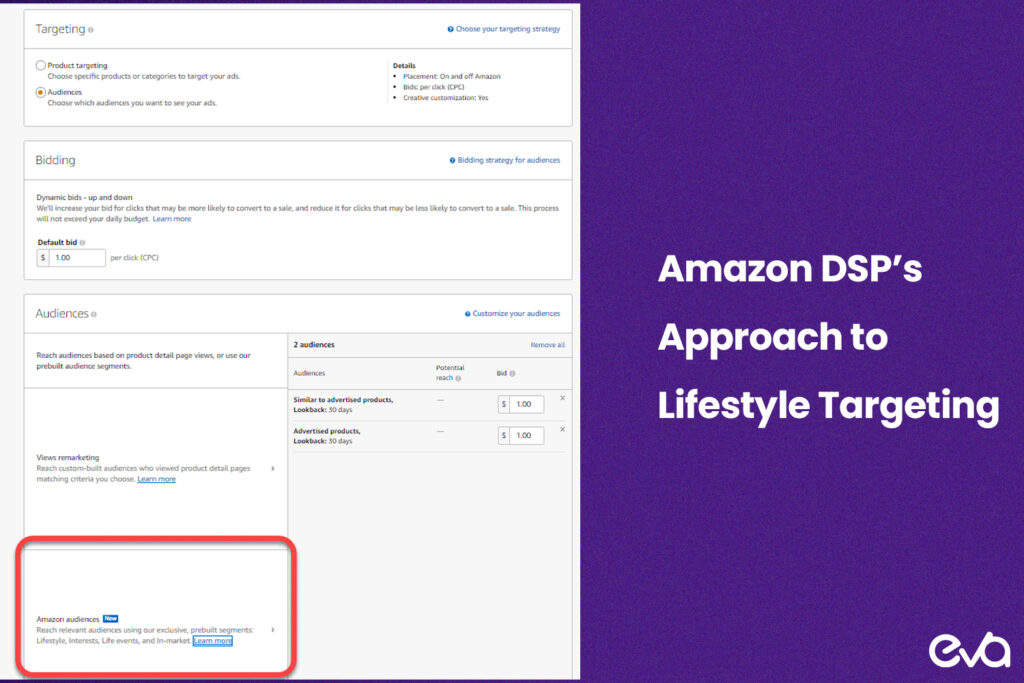
Retargeting and Remarketing
Retargeting and remarketing are critical components of a successful Amazon DSP strategy.
These techniques involve re-engaging users who have previously interacted with your brand but have not yet converted, driving them back to your site to complete the desired action.
How Retargeting Works in Amazon DSP
Retargeting in Amazon DSP involves tracking users who have visited your website or engaged with your brand in some way and then serving them targeted ads as they browse other websites or apps.
This is done using cookies or pixel-based tracking that follows users across the web, allowing advertisers to remind potential customers of the products they viewed but did not purchase.
Strategies for Effective Remarketing Campaigns
- Personalized Messaging: Customize ad copy and visuals to reflect the user’s previous interactions with your brand.
- Dynamic Ads: Use dynamic ads that automatically populate with products the user has shown interest in.
- Segmented Remarketing: Create segments within your retargeting audience, such as users who have visited your website multiple times versus those who visited once. Tailor your messaging to each segment to maximize relevance.
How It Differs from Other Targeting Methods
Unlike demographic or behavioral targeting, which focus on age, gender, or online behaviors, lifestyle targeting considers the broader context of a consumer’s life.
It takes into account the activities they enjoy, the causes they support, and the communities they belong to.
This deeper understanding enables brands to create more meaningful connections with their audience.
The Role of Psychographics in Lifestyle Targeting
Psychographics play a crucial role in lifestyle targeting. While demographics tell us who the consumers are, psychographics tell us why they make certain choices.
By analyzing psychographic data, such as values, beliefs, and motivations, advertisers can tailor their messaging to align with the emotional drivers behind consumer behavior.
Examples of Lifestyle Segments Used in Amazon DSP Campaigns
- Health-Conscious Consumers: Targeting individuals who prioritize health and wellness, promoting products like organic foods, fitness equipment, or wellness apps.
- Tech Enthusiasts: Reaching tech-savvy consumers who are interested in the latest gadgets, software, and online services.
- Eco-Friendly Shoppers: Engaging with consumers who are committed to sustainability, offering products that are environmentally friendly or ethically sourced.
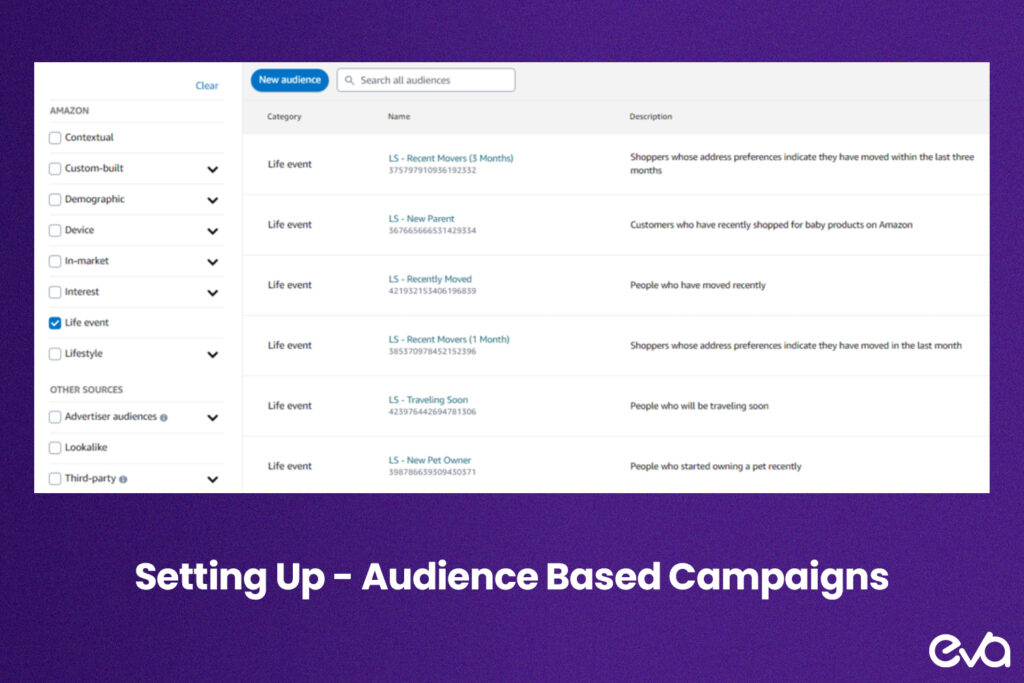
Benefits of Lifestyle Targeting
Lifestyle targeting in Amazon DSP offers several unique advantages that can significantly enhance the effectiveness of advertising campaigns.
By understanding and leveraging the interests, behaviors, and values of consumers, advertisers can create more relevant and engaging ads, leading to better overall campaign performance.
Increased Relevance and Engagement
One of the primary benefits of lifestyle targeting is the ability to deliver ads that are highly relevant to the audience.
When ads align with the interests and values of the consumer, they are more likely to capture attention and drive engagement.
This relevance translates into higher engagement rates, as consumers are more inclined to interact with ads that speak to their lifestyle.
Higher Conversion Rates and ROI
Lifestyle targeting also leads to higher conversion rates. By focusing on consumers who are already interested in the type of products or services being advertised, lifestyle targeting reduces the amount of wasted ad spend.
This targeted approach not only increases conversion rates but also boosts the return on investment (ROI) for advertising campaigns.
Enhanced Customer Loyalty Through Personalized Ads
Another significant benefit of lifestyle targeting is its ability to foster customer loyalty. By consistently delivering ads that align with a consumer’s values and interests, brands can build a deeper connection with their audience.
Over time, this connection can lead to increased brand loyalty, as consumers feel understood and valued by the brand.
The Impact of Lifestyle Targeting on Long-Term Brand Building
Lifestyle targeting not only drives short-term results but also contributes to long-term brand building.
By consistently reaching the right audience with relevant messaging, brands can establish themselves as leaders in their respective industries.
Over time, this leads to stronger brand recognition and a positive brand image, as consumers come to associate the brand with the values they hold dear.
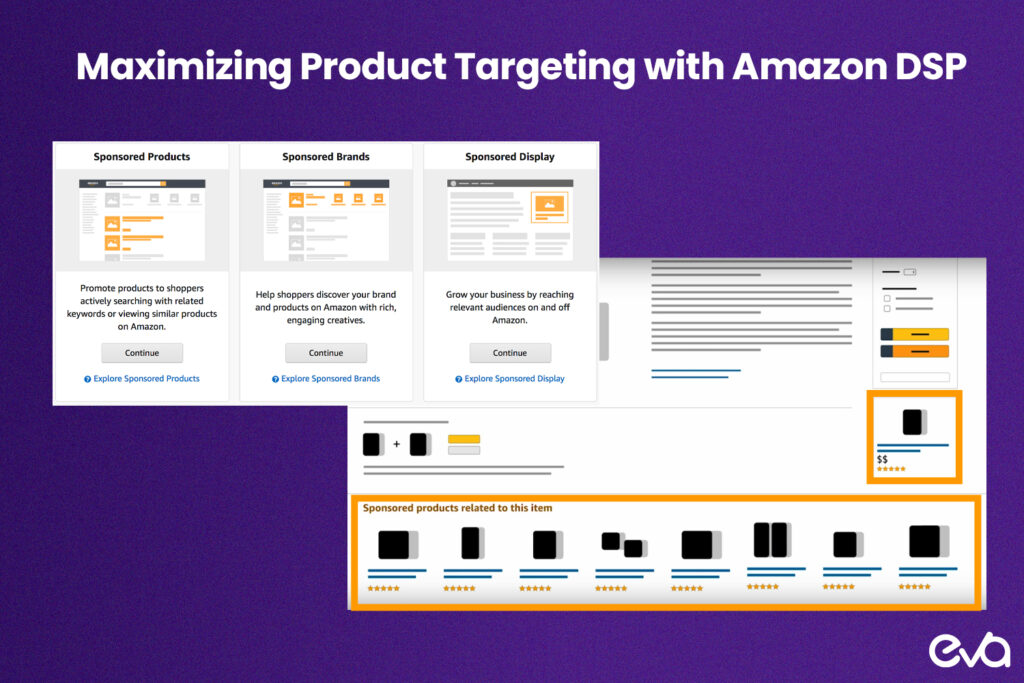
How Amazon DSP Implements Lifestyle Targeting
Amazon DSP is uniquely positioned to implement lifestyle targeting effectively due to its access to vast amounts of first-party data and advanced targeting tools.
This section explores how Amazon DSP integrates lifestyle data into its targeting strategies and the tools and technologies that make this possible.
Amazon DSP’s Approach to Lifestyle Targeting
Amazon DSP leverages a combination of first-party data, insights, and machine learning algorithms to implement lifestyle targeting.
This approach involves collecting detailed information about consumer behaviors, interests, and preferences, which is then used to create highly targeted ad campaigns.
Integration of Lifestyle Data and Insights
The integration of lifestyle data into Amazon DSP campaigns is a multi-step process:
- Data Collection: Amazon collects data from various sources, including browsing history, purchase behavior, and engagement with specific types of content. This data is then categorized into different lifestyle segments, such as fitness enthusiasts, tech-savvy consumers, or eco-conscious shoppers.
- Audience Segmentation: Using the collected data, Amazon DSP segments audiences into distinct lifestylesegments, refining them based on additional factors like demographics and geographic location.
- Campaign Execution: Once the audience segments are defined, Amazon DSP uses this information to deliver ads that are tailored to the lifestyle of each segment.
- Performance Optimization: Amazon DSP continuously monitors performance metrics to optimize the targeting and ensure that the ads are reaching the most relevant audience.
How Lifestyle Targeting is Used in Amazon DSP Campaigns
Lifestyle targeting in Amazon DSP campaigns is used to deliver highly personalized ads that resonate with specific audience segments.
These campaigns often involve a combination of display, video, and audio ads, all designed to appeal to the lifestyle choices of the target audience.
Tools and Technologies Used to Gather Lifestyle Data
- Amazon’s First-Party Data: Amazon’s vast data resources provide crucial insights into consumer behaviors and preferences.
- Machine Learning Algorithms: These algorithms analyze consumer data to identify patterns and trends that can be used to create lifestyle segments.
- AI-Powered Insights: Artificial intelligence is used to generate insights from the collected data, helping advertisers understand which lifestyle segments are most likely to engage with their ads.
Strategies for Effective Lifestyle Targeting with Amazon DSP
Setting Up Lifestyle Targeting Campaigns
- Define Your Campaign Objectives: Start by clearly defining what you want to achieve with your campaign.
- Identify Your Target Lifestyle Segments: Based on your product or service, identify which lifestyle segments are most relevant.
- Choose Your Ad Formats: Select the formats that best suit your campaign objectives and target audience.
- Set Up Targeting Parameters: Use Amazon DSP’s targeting options to set up your campaign to reach the chosen lifestyle segments.
- Design Creative Assets: Ensure that your ad creatives resonate with the lifestyle of your target audience.
- Launch and Monitor the Campaign: Once your campaign is live, monitor its performance closely.
Best Practices for Targeting Lifestyle Segments
- Align Ad Messaging with Lifestyle Values: Ensure that your ad messaging aligns with the values and interests of your target audience.
- Use Dynamic Creative Optimization (DCO): DCO allows you to automatically tailor your ad creatives to different audience segments.
- Leverage Lookalike Targeting: Use lookalike targeting to reach new audiences that share characteristics with your existing customers.
How to Test and Refine Your Lifestyle Targeting Strategy
- A/B Testing: Conduct A/B tests to compare different ad creatives, messaging, and targeting strategies.
- Analyze Performance Data: Use Amazon DSP’s analytics tools to analyze the performance of your campaign.
- Iterate Based on Insights: Make iterative changes to your targeting strategy based on your analysis.
Tips for Scaling Lifestyle Targeting Campaigns for Larger Audiences
- Expand Your Target Segments: Consider expanding your targeting to include additional lifestyle segments that align with your brand.
- Increase Ad Spend Strategically: Gradually increase your ad spend in segments that are performing well.
- Optimize for Efficiency: Focus on optimizing your campaign for efficiency as you scale.
Optimizing Lifestyle Targeting
Optimization is key to maintaining the effectiveness of lifestyle targeting campaigns over time.
Techniques for Refining and Improving Targeting
- Segmentation Refinement: Regularly review and refine your audience segments to ensure they remain relevant.
- Exclusion Targeting: Use exclusion targeting to avoid showing ads to users who are unlikely to convert.
- Frequency Capping: Implement frequency capping to limit the number of times a user sees your ad.
Using Data and Analytics to Enhance Campaign Performance
- Track Key Metrics: Monitor key performance indicators (KPIs) such as click-through rates (CTR), conversion rates, and return on ad spend (ROAS).
- Use Predictive Analytics: Predictive analytics can help you anticipate future trends and adjust your targeting strategy accordingly.
- Adjust Bidding Strategies: Based on the performance data, adjust your bidding strategies to maximize ROI.
How to A/B Test Lifestyle-Targeted Ads
- Set Clear Objectives: Before conducting an A/B test, define what you want to achieve.
- Create Variants: Develop different variants of your ads, each with a unique element that you want to test.
- Analyze Results: After running the A/B test, analyze the results to determine which variant performed better.
- Implement Learnings: Use the insights gained from your A/B tests to refine your targeting strategy.
Ad Examples and Creative Strategies
Crafting the right ad creatives is essential for the success of lifestyle targeting campaigns in Amazon DSP.
Types of Ads That Work Well with Lifestyle Targeting
- Display Ads: Versatile and can be tailored to fit the interests and behaviors of lifestyle segments.
- Video Ads: Particularly effective for lifestyle targeting because they allow for storytelling that resonates with the audience’s values.
- Audio Ads: Target listeners based on their music preferences and other lifestyle indicators.
- Native Ads: Blend seamlessly with the content they appear alongside, making them less intrusive and more engaging.
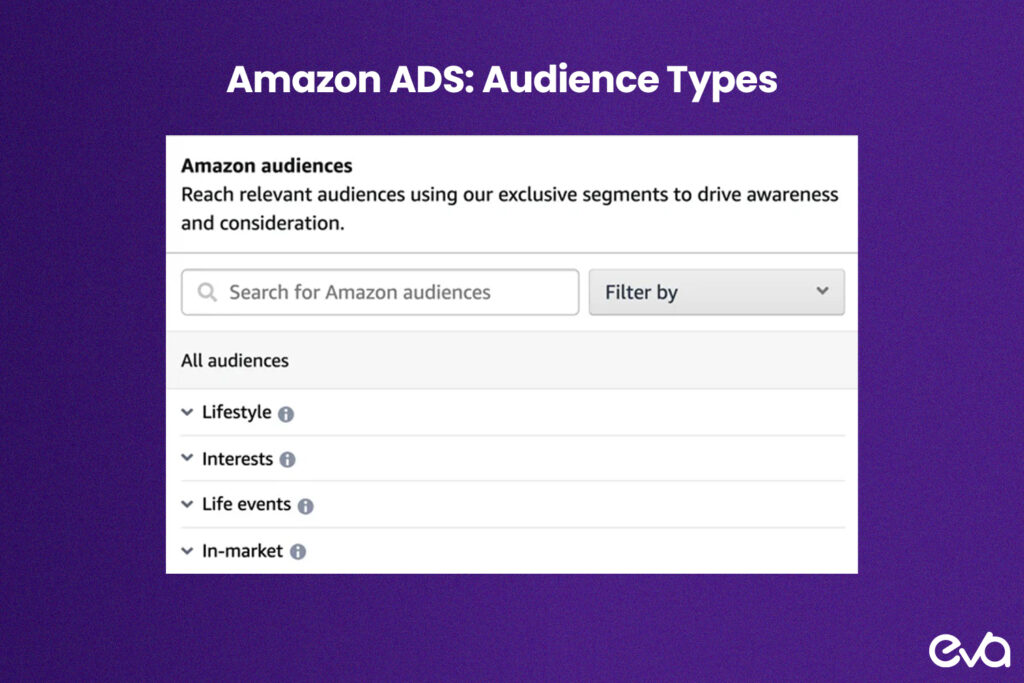
Creative Strategies to Engage Lifestyle-Targeted Audiences
- Use Storytelling: Craft stories that align with the values and experiences of your target audience.
- Focus on Visual Appeal: Use imagery that resonates with the lifestyle and interests of your audience.
- Incorporate User-Generated Content (UGC): UGC can add authenticity to your campaigns.
- Leverage Seasonal and Cultural Events: Tailor your ads to align with seasonal trends or cultural events relevant to your target lifestyle segments.
How to Design Ads That Resonate with Specific Lifestyle Segments
- Personalize Messaging: Use messaging that speaks directly to the lifestyle choices of your audience.
- Align Visuals with Lifestyle Preferences: Ensure that your visuals align with the preferences of your lifestyle segments.
- Create Contextual Relevance: Place your ads in environments where they are contextually relevant.
How Eva Can Enhance Your Amazon DSP Campaigns
Eva has a powerful tool that complements Amazon DSP by providing advanced analytics, optimization features, and automation capabilities.
Introduction to Eva Commerce
Eva is an advanced platform designed to optimize and manage Amazon DSP campaigns.
Overview of Eva and Its Functionalities
- Advanced Analytics: Eva offers in-depth analytics that go beyond basic performance metrics.
- Automation: The platform automates many aspects of campaign management.
- AI-Powered Optimization: Eva uses artificial intelligence to analyze campaign data and make real-time adjustments.
How Eva Integrates with Amazon DSP
Eva integrates seamlessly with Amazon DSP, allowing advertisers to manage all aspects of their campaigns from a single platform.
Benefits of Using Eva for Campaign Management
- Increased Efficiency: Automation tools reduce the time and effort required to manage campaigns.
- Improved Targeting Accuracy: Eva’s advanced analytics enhance targeting accuracy.
- Better ROI: Eva helps advertisers achieve better ROI by optimizing every aspect of the campaign.
Showcasing Eva’s Impact on Campaign Performance
- Consumer Electronics Brand: Achieved a 20% increase in conversions and a 15% reduction in CPA.
- Health & Wellness Company: Saw a 25% increase in ad engagement and a 30% improvement in overall campaign performance.
Conclusion
This article has explored how Amazon DSP offers unique advantages for targeted advertising, particularly through lifestyle targeting.
We’ve covered how Amazon DSP differs from traditional platforms by providing precise audience segmentation, broad reach across platforms, and detailed analytics.
The main takeaway is that lifestyle targeting with Amazon DSP allows advertisers to create personalized ad experiences that lead to higher engagement, better conversion rates, and stronger customer loyalty.
By using Amazon DSP’s advanced features, brands can connect with audiences based on their specific interests, behaviors, and values.
This approach not only boosts the effectiveness of advertising campaigns but also supports long-term brand growth.
Ready to take your Amazon DSP campaigns to the next level? Book a meeting now!
FAQs
Lifestyle targeting focuses on reaching audiences based on their interests, values, and overall lifestyle choices, while behavioral targeting is based on specific actions and behaviors, such as browsing history or past purchases. Lifestyle targeting is more about understanding the broader context of a consumer’s life, whereas behavioral targeting is more focused on specific, actionable data points.
Success in lifestyle targeting campaigns can be measured using several key metrics, including click-through rates (CTR), conversion rates, return on ad spend (ROAS), and customer lifetime value (CLTV). Additionally, tracking engagement metrics like time spent on site and repeat visits can provide insights into the effectiveness of your campaigns.
Yes, lifestyle targeting can be effectively combined with other targeting strategies such as demographic, geographic, and behavioral targeting. This multi-faceted approach allows for more precise audience segmentation and can lead to higher engagement and conversion rates.
Best practices for lifestyle targeting include aligning your ad messaging with the values and interests of your target audience, using dynamic creative optimization to personalize ads for different segments, and continuously testing and refining your targeting strategy based on performance data.
Lifestyle targeting criteria should be reviewed and updated regularly based on changes in consumer behavior and performance metrics. A quarterly review is a good starting point, but more frequent adjustments may be necessary during high-traffic periods or when launching new campaigns.

